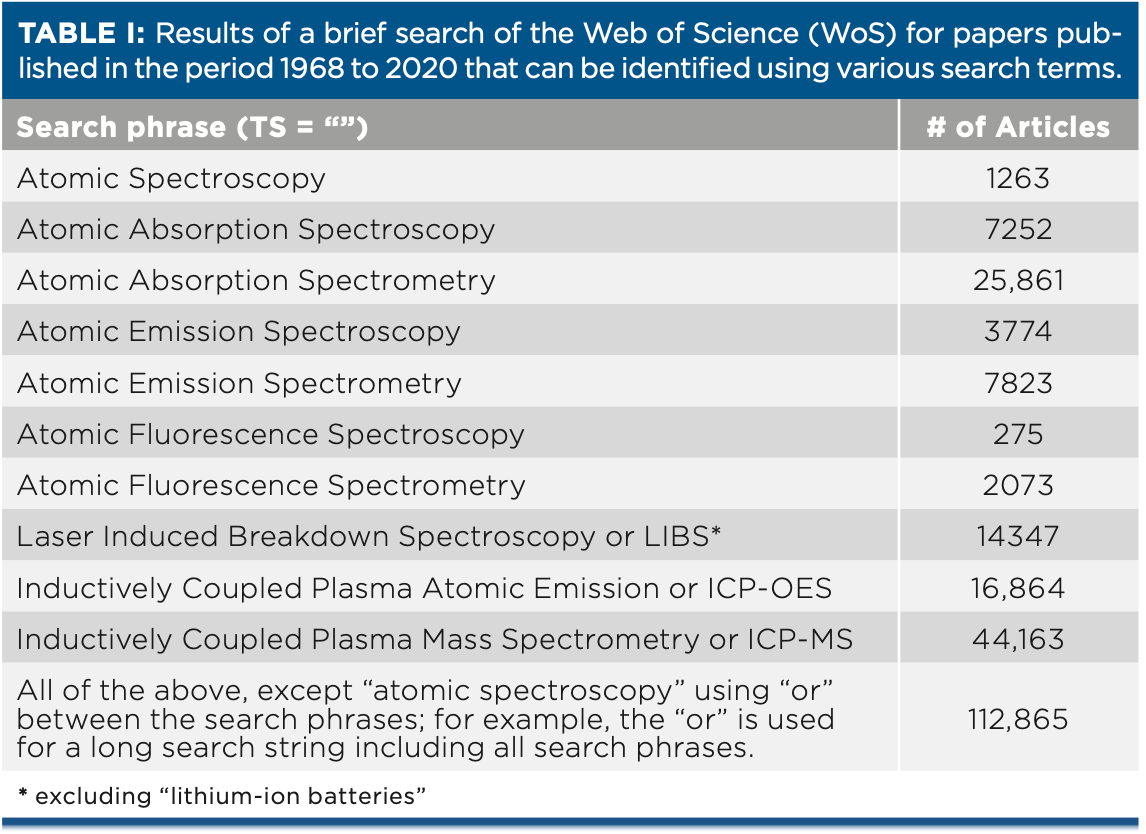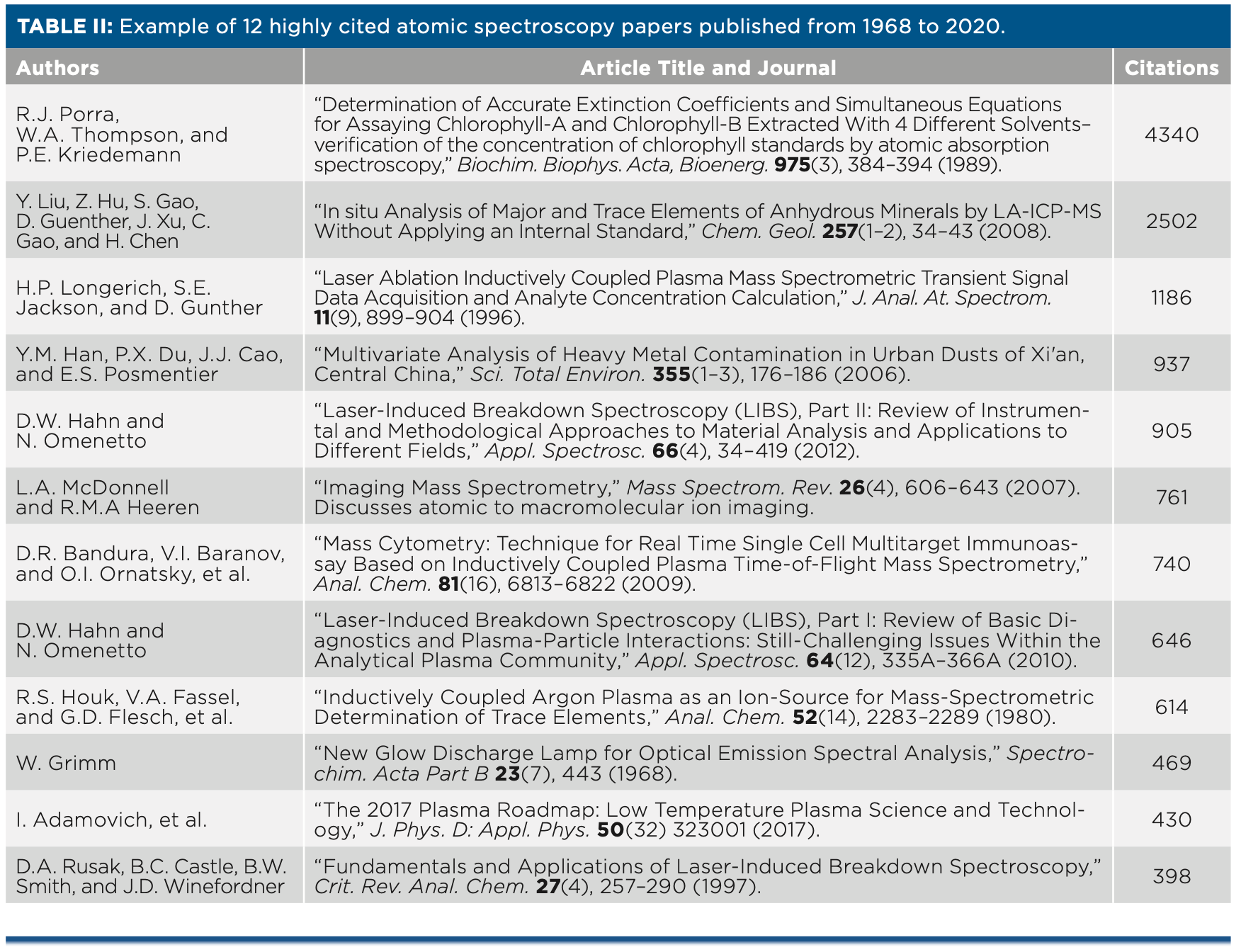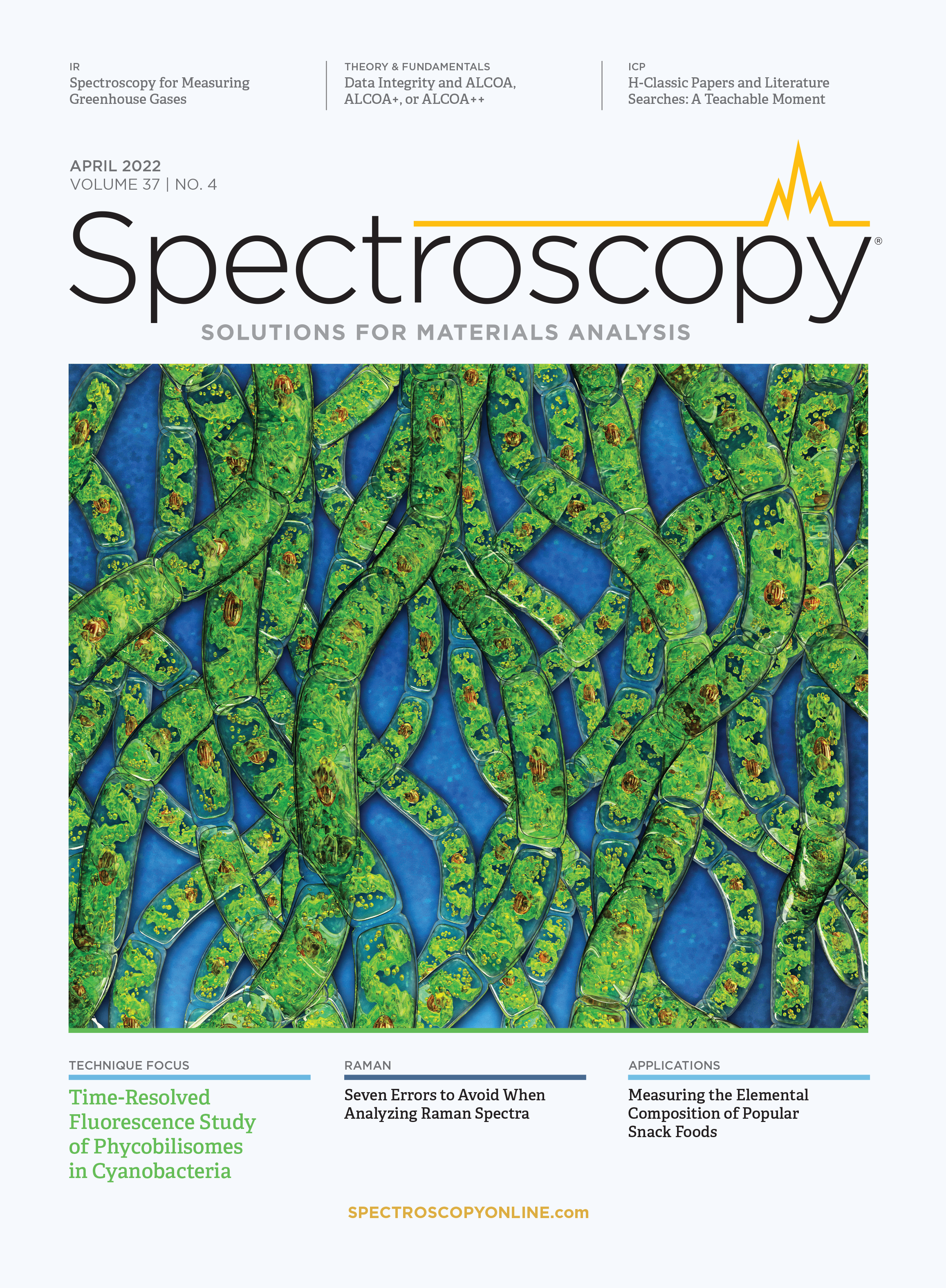Letters to the Editor: H-Classic Papers in Atomic Spectroscopy
To the Editor:
I write in response to the paper by Muhammad Rahil Rafiq and Sadiq M. Sait, “H-Classic Papers in Atomic Spectroscopy: An Integrative Literature Review,” published in the November 2021 issue of Spectroscopy (1). Rafiq is an engineer and Sait is a professor, both in the Center for Communications and IT Research at King Fahd University of Petroleum and Minerals in Dhahran, Saudi Arabia.
The paper is intended to provide insights into the key papers and researchers that have influenced the field of analytical atomic spectroscopy. As someone who worked in the field of atomic spectroscopy as a graduate student, postdoctoral fellow, and university researcher for about 30 years (from 1976 to 2005), I was keen to read the review. Unfortunately, I was quite disappointed. The publication is badly flawed as a result of a lack of knowledge about the history, evolution, and current state of the field. The problem is that the authors are computer engineers with no real knowledge of atomic spectroscopy. This was purely an academic exercise.
For their study, the authors searched the Web of Science (WoS) in April 2020, using the search term atomic spectroscopy (referred to as a topic search, or “TS”). The search query resulted in 1214 articles. The small number of documents was the first indication that something was amiss. An author search for only two of the most well-known and cited researchers in analytical atomic spectroscopy, Gary Hieftje and Jim Winefordner, yields 615 and 746 articles, respectively, for a total of 1361 articles. The fact that the list that didn’t include Hieftje, only named Winefordner as 45th, and omitted hundreds of other “household names” who have contributed to the atomic spectroscopy literature, also raises concerns about the methodology. These omissions were obvious to me because I am quite familiar with the field of atomic spectroscopy.
The core problem with the methodology is that atomic spectroscopy is a blanket term that includes many subdisciplines, such as atomic emission spectroscopy, atomic absorption spectroscopy, atomic fluorescence spectroscopy, inductively coupled plasma–mass spectrometry (ICP-MS), ICP-optical emission spectroscopy (ICP-OES), and laser-induced breakdown spectroscopy (LIBS). Other related techniques include laser-based atomic spectroscopy for inorganic analysis such as laser-enhanced ionization, coherent forward-scattering spectrometry (CFS), resonance-ionization spectroscopy and spectrometry, and X-ray fluorescence. In addition to these techniques, there are associated topics, such as sample introduction systems (such as nebulizers, spray chambers, and hydride generation), and data-analysis methods such as background correction and multivariate analysis. Scientists in the field also often use the term spectrometry in addition to spectroscopy. Many authors identify the topic of their manuscript using the subdisciplines identified above rather than the blanket term atomic spectroscopy, so a search using that phrase would miss many important and relevant publications.
To give some insight into the numbers of papers published in these subdisciplines, I have carried out a search in the WoS Core Collection for which “Science Citation Index–Expanded” is one of the indexed sources. I limited my search to the period 1968 to 2020, to match the search carried out in the paper under discussion. Table I below summarizes the results of this exercise. This search was no means exhaustive or comprehensive; it is presented simply to give some insight into the scope of papers published in atomic spectroscopy. The table shows that tens of thousands of atomic spectroscopy articles are missed in a search using only the search term atomic spectroscopy.

The authors also presented a table with the caption “H-classic papers in atomic spectrometry with their available impact factors (JCR).” The highest cited article in the table received 503 citations and the lowest received 64. As a comparison, I searched for the number of citations for a sample set of 12 highly cited atomic spectroscopy papers published from 1968 to 2020. The purpose here is to give an indication of some of the papers and authors that could be considered “citation leaders,” but did not appear in the authors’ table. This information is presented in Table II below. The least cited of these papers received 398 citations. There are hundreds of papers that have received in excess of 200 citations.

As a small step toward setting the record straight, I would like to briefly name a few scientists who were innovators and leaders in analytical atomic spectroscopy over the past six decades—scientists who developed new instruments, methods, and applications, and defined and advanced the field: James D. Winefordner, Gary Hieftje, Chuni Chakrabarti, Ralph Sturgeon, Ramon Barnes, Paul Boumans, Leo de Galan, Klaus Dittrich, Michael Epstein, Jim Harnley, Heinz Falk, Wolfgang Frech, Keiichiro Fuwa, Jim Holcombe, Gordon Kirkbright, Alan Walsh, Boris L’vov, Gary Holick, Kay Nimax, Walter Slavin, Jose Broekaert, Igor Gornushkin. Detlef Gunther, Sam Houk, Velmer Fassel, Javier Laserna, Arne Bengtson, John Olesik, Vincenzo Palleschi, Rick Russo, Frank Vanhaecke, Benli Huang, Nicolo Omenetto, Margaretha de Loos-Vollebregt, Annemie Bogaerts, Norbert Jakubowski, R. Kenneth Marcus, Don Douglas, and Scott Tanner. These are just a few whose contributions to atomic spectroscopy have been seminal.
My concern is not only with the shortcomings of the specific search methodology used in the published study. Because even if the authors’ search had used all the relevant terms to capture the breadth of the field, there would still be important limitations to trying to understand the significance of papers and authors using metrics alone. Even “ideal” metrics generally fall short. For example, are the most-cited papers necessarily the seminal papers that open and develop new lines of research and instrument and techniques? I would argue no.
In this context, it would be useful to have a curated compilation of the key papers in analytical atomic spectroscopy. Fortunately, just such a compilation is being prepared, by George Chan, a research scientist in the Laser Technologies Group at Lawrence Berkeley National Laboratory; Gary Hieftje, a professor emeritus from the Department of Chemistry at Indiana University, and Nicoló Omeneto, a research professor in the Department of Chemistry at the University of Florida. Starting three years ago, they consulted a large group of established scientists in the field of atomic spectroscopy and asked for a list of important papers published over the past 50 years—on theory, historical developments, fundamental studies and characterization, instrumentation, spectrochemical techniques or tricks, common but often overlooked mistakes and experimental precautions, philosophy of spectrochemical analysis, and any other relevant topics. From those suggestions, the project leads (Chan, Hieftje, and Omenetto) will compile a curated list of all the papers suggested, the individuals who suggested them, the suggested key points, and any additional background information or anecdotes. The curated list will be published in the near future as a single review article. This paper is expected to be a definitive compilation of the most important, influential, and in some cases, most highly cited papers of the past half-century in the field of analytical atomic spectroscopy. As is required for such an endeavor, it will be assembled and curated by experts in analytical atomic spectroscopy.
To end, I applaud the authors of “H-Classic Papers in Atomic Spectroscopy: An Integrative Literature Review” for attempting to shine a spotlight on an important field of endeavor. However, I would ask that, if they are considering future efforts of this kind, they consult with established scientists and experts in the field to understand the full picture before publishing a similar review.
Editor, Applied Spectroscopy
Department of Chemistry
The University of British Columbia
Vancouver, BC, Canada
Reference
(1) R. Rafiq and S.M. Sait, Spectroscopy 36(11), 28–34,40 (2021). https://www.spectroscopyonline.com/view/h-classic-papers-in-atomic-spectroscopy-an-integrative-literature-review
The Authors Respond
Our paper, “H-Classic Papers in Atomic Spectroscopy: An Integrative Literature Review,” focuses only on a set of papers (data harvested in April 2020) for analysis or review that fit our criteria of “H-Classics.” The selection criteria are elaborated in Section 2.3 of the manuscript. Other details about the selection of document types, topics (ts) which include titles, abstract, keywords, and so forth, are also discussed in the manuscript.
The main concern raised by Dr. Blades and other readers regards papers missing from the data set produced by our search terms. The reason for this is that the keywords we used for our search string focused only on atomic spectroscopy. This approach led to excluding other keywords or terms such as atomic emission spectroscopy or atomic absorption spectroscopy and so forth. Therefore, we acknowledge that the scope of our data set is very limited (because of the search string).
We would like to follow up with some discussion of issues related to how to develop a search string that can yield much more comprehensive results.
As an example, if we would like to work on the literature of “cloud computing,” we might use a search query of “ts=cloud”. Such a search will also retrieve publications related to rain, storms, and precipitation, which are completely out of scope for the research domain we seek to cover. Therefore, content analysis and scrutiny is needed, related to the most significant (primary) keywords, in order to avoid bias. The expertise of subject-matter domain experts is required to screen results by manual exclusion/inclusion to exclude or include relevant and irrelevant data.
In Web of Sciences (WOS), truncation, also called wildcard characters, can be used, at the beginning, middle, or end of words or phrases, and also with their combinations. Three main symbols (*, $, and ?) are used, as follows:
- The asterisk (*) is used for retrieving multiple characters. It also matches zeroes and non-spaced characters. It can be used to find relevant keywords for prefixes, suffixes, and spelling variations. For example, a search for star* will provide results that include both starch and starvation.
- The dollar symbol ($) is used for retrieving a single character with zero or one non-space character, variations, or plural forms. For example, a search for colo$r returns results that include both color and colour.
- The question mark (?) is used to retrieve a single (or repeated) character. For example, a search for organi?ation will provide results that include organization, organizations, organisations, and organisational.
In addition to the above, the Boolean operators OR, AND, and NOT are also available.
With respect to the valuable comments from Dr. Blades, we completely agree with him that our query is by no means sufficient for an exhaustive or comprehensive search. We would like to gratefully acknowledge and thank him for his valuable insights, referring to more relevant keywords. However, including them in the search query still excludes many more papers related to atomic spectroscopy, examples of which are: photoacoustic spectroscopy, photoelectron spectroscopy, and photoemission spectroscopy. Therefore, the query given below could be used, followed by a manual scan which is essential, to have a more relevant set of papers on atomic spectroscopy:
TS=”*Spectrosc*” or TS=”*Spectrome*”
This approach seems more likely to capture the major publications related to atomic spectroscopy to be adequately considered for a more comprehensive review. But, again, extracted data should be accessed by domain experts to ensure irrelevant documents are removed, and that all relevant documents have been captured—as Dr. Blades points out. That should lead to a more accurate coverage of the topic.
Lastly, considering the major limitation of any literature search, no precise query constitutes a comprehensive literature search in a broad discipline. Efforts can be made to draw a comprehensive picture with greater and essential representation of overall knowledge but still some documents might always be missing.
Perhaps, the above recommended query may not be the perfect one, but using more truncations and Boolean operators, to include and exclude more relevant keywords, will definitely help in better defining the scope of literature or data set.
Center for Communications and IT Research
King Fahd University of Petroleum and Minerals
Dhahran, Saudi Arabia

Atomic Perspectives: Highlights from Recent Columns
March 3rd 2025“Atomic Perspectives,” provides tutorials and updates on new analytical atomic spectroscopy techniques in a broad range of applications, including environmental analysis, food and beverage analysis, and space exploration, to name a few. Here, we present a compilation of some of the most popular columns.
Pittcon 2025: Highlighting Talks on Atomic Spectroscopy
February 26th 2025At Pittcon this year, there will be numerous sessions dedicated to spotlighting the latest research that uses atomic spectroscopy or elemental analysis techniques. We highlight some of these talks below that might pique the interest of spectroscopists and researchers attending the conference this year.